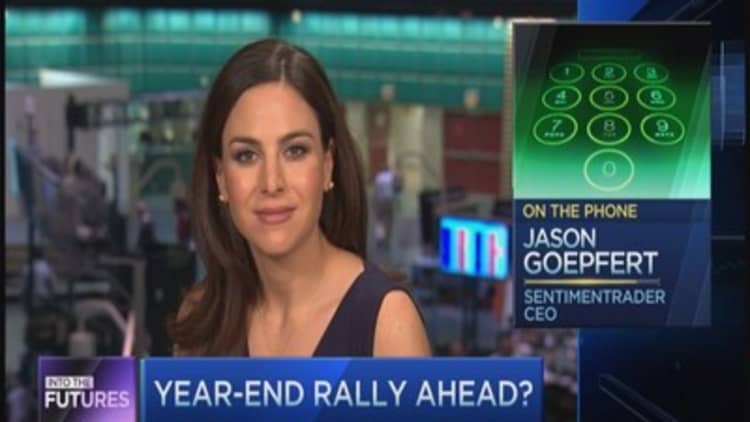
The stock market has heated up mightily after a swift October rout, with the S&P 500 6 percent higher in a month. And history suggests that it could soon get even better for the bulls.
In the 20 times when the S&P 500 has enjoyed moderate gains (between 0 and 15 percent) in the year to Thanksgiving, the S&P has added to those gains 18 of 20 times, according to Jason Goepfert of SentimenTrader. He also notes that "when it does decline, typically it's very, very small, so when you look at risk-reward just based on the time of the year, it's very, very positive."
Interestingly, if we alternately look at years in which the S&P is up 10 percent or more, the results are somewhat more mixed. When Goepfert, going back to 1950, looks solely at the 28 years in which the S&P was up 10 percent or more at Thanksgiving, 68 percent of the years were positive, with those 28 years averaging a healthy return of 2.4 percent between Thanksgiving and New Year's.
"There was actually a negative correlation between the pre-holiday and the post-holiday returns, suggesting that buying pressure earlier in the year exhausted some of the post-holiday enthusiasm," he wrote to CNBC.
What makes this a bit confusing is that performance-chasing is often credited for the year-end rally. In other words, underperforming managers are thought to take heavily bullish positions toward the end of the year in an attempt to make up for lagging the market during most of the year.
However, that would seem to be an argument for proportional gains pre- and post-Thanksgiving; the fact that more enthusiastic action ahead of the turkey carving seems to presage more muted action into New Year's seems to suggest that something else is going on here.
One explanation is that when stocks are up significantly, beating a benchmark like the S&P becomes a bit less important. Since few clients will kvetch about 15 percent gains in any market environment, hanging on to existing profits becomes more important than chasing fresh ones.
"If portfolio managers have great gains going into December, why mess it up at the end of the year?" Canaccord Genuity's chief equity strategist, Tony Dwyer, asked rhetorically. "You don't want to lose the good results you've got."
But Dwyer adds that there's more to the end-of-year rally than performance-chasing. He says that corporations and those on Wall Street who track them tend to move from optimism, to pessimism, and back to optimism in a quasi-predictable annual pattern.
"Views are optimistic going into the new year," he said. In fact, analysts and strategists tend to start off every year positive, and then "halfway through the year you realize, 'Oh damn, my numbers are too high!' Then, by the time you get to October, November, December, you start to think 'Oh, next year seems like a pretty good year.'"
The same is true on the corporate side. Around the holidays, corporate officers "aren't talking about how they're not going to make their year. Companies always want to believe that they're going to do better next year," Dwyer said.
So is it wise for investors to take advantage of these fundamental and less-fundamental drivers of year-end performance?
"I think people need to take a lot of these prescriptions with a grain of salt," said Michael Chadwick, CEO of Farmington, Connecticut-based investment advisor Chadwick Financial Advisors.
Unlike Dwyer, who has been consistently (and correctly) bullish, Chadwick is extremely worried about market valuations. That gives him a reason not to attempt to take advantage of market anomalies like the so-called Santa rally.
"Investing is always about what you paid for the asset, and right now it's a very dangerous game to play. I tell folks that I don't have the confidence to swing the bat hard," Chadwick said. "We're just in this big bubble right now, so it's hard for these 'rules of thumb' to play out."
Watch "Futures Now" Tuesdays and Thursdays at 1 p.m. ET exclusively on FuturesNow.CNBC.com!



